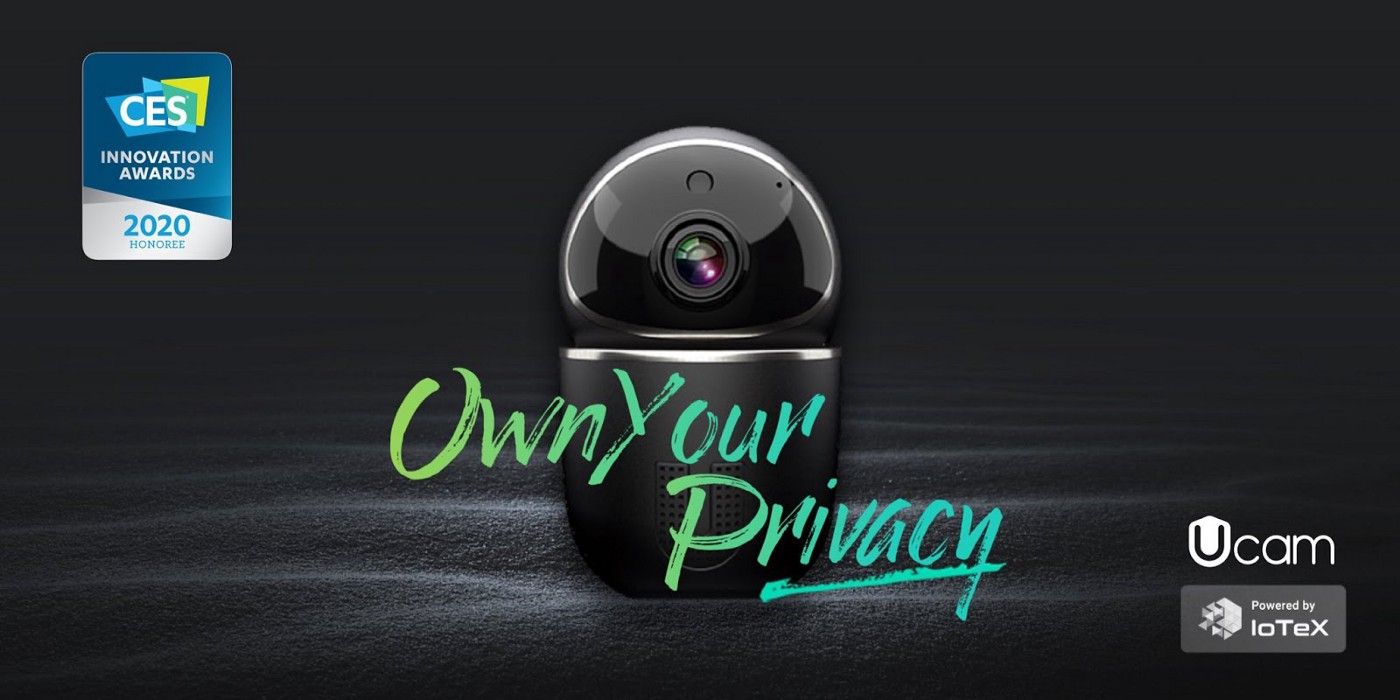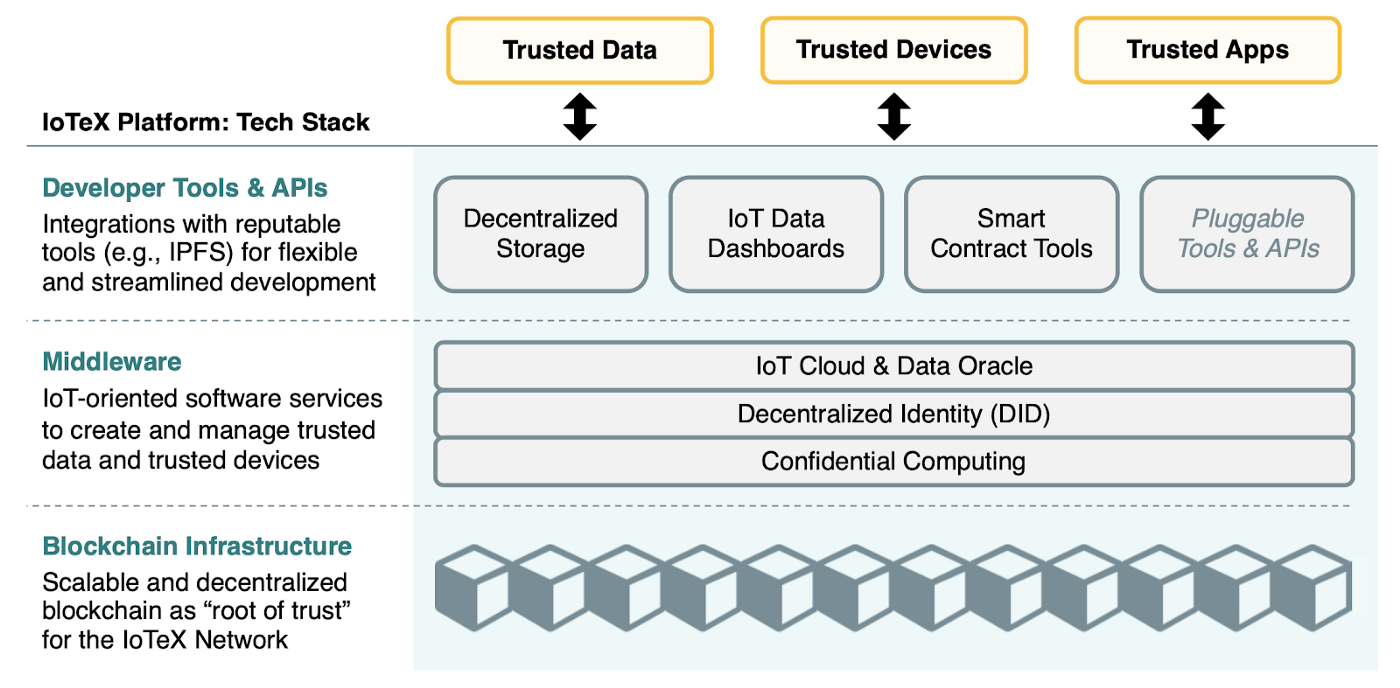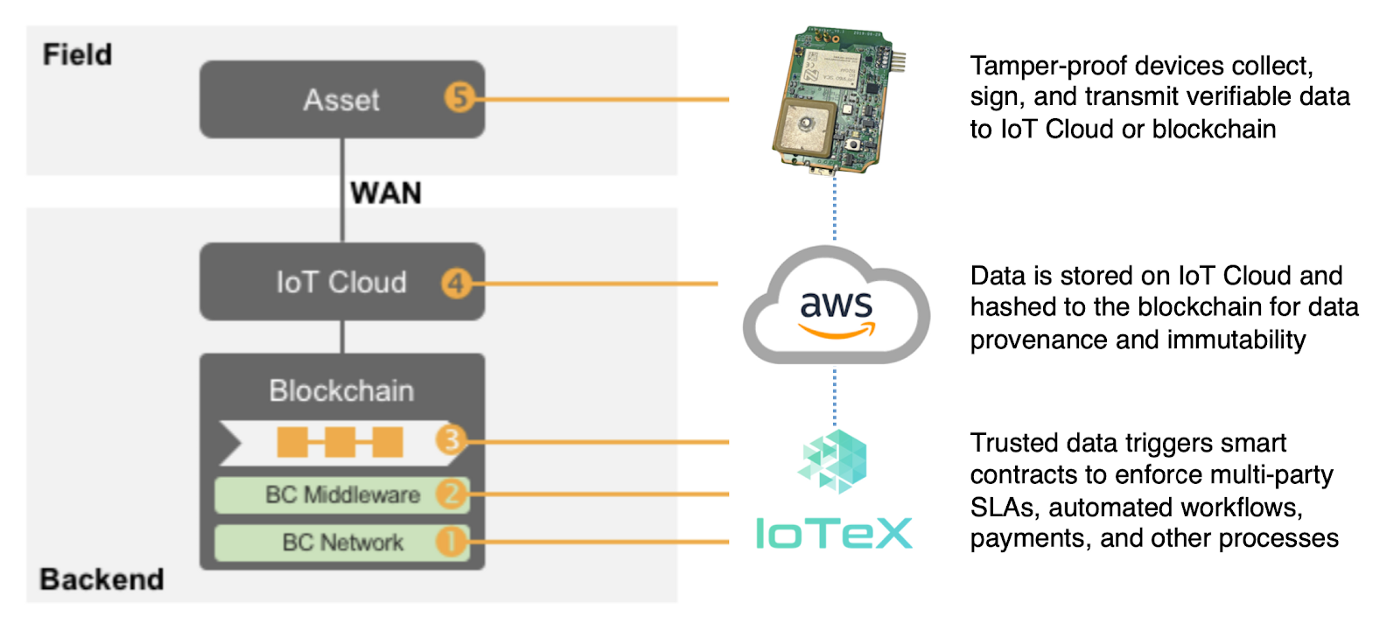IoTeX AMA with Minted Lab
On May 13, IoTeX held a special AMA with Minted Lab, a top Korean crypto community.

On May 13, IoTeX held a special AMA with Minted Lab, a top Korean crypto community. Larry Pang, Head of Business Development @ IoTeX, shared insights and perspectives on IoTeX architecture, current use cases, future plans, and comparisons to other blockchain/IoT/privacy projects. Enjoy!
Is it easy for IoTeX to handle high-volume data? I understand that IoTeX has developed a multi-layer architecture for scalability and speed. I wonder what the results are?
The IoTeX platform utilizes a unique architecture to meet the unique demands of Internet of Things (IoT) use cases. Our multi-layer architecture combines smart devices, IoT Cloud + decentralized storage, and blockchain. Let me describe each of these layers:
- Device Layer: IoTeX is all about generating trusted data from trusted devices to enable trusted applications. A critical piece of this is the device layer. To trust a device, it must have a verifiable identity and its actions must be verifiable by others, which is exactly what IoTeX enables by combining secure hardware and blockchain, two tamper-proof technologies.
- Storage Layer: IoT devices generate a lot of data, and not all of that can be stored on the blockchain due to cost/scalability reasons. But today, more and more data validation and processing is performed “on the edge” or on the device itself, reducing the need to store large amounts of unfiltered data on servers. A scalable and flexible approach is to store/index pre-processed data on the IoT Cloud (e.g., AWS) or decentralized storage (e.g., IPFS, Sia) and “hash” them to the blockchain, which provides timestamped verifiability and data provenance. When needed, this data can be written to the blockchain for use in smart contracts
- Blockchain Layer: the root of trust for the entire IoTeX Network. Our blockchain is open source and one of the fastest in the entire industry — not only does it enable standard P2P transactions and smart contracts, but it is also used to register device identities and “hash” data (stored on Cloud/decentralized storage) to the blockchain.
The combination of these three layers provides great flexibility for developers and builders. For more information, please see our Blockchain & IoT Reference Architecture.
IoTeX received attention by announcing Ucam at CES 2020. Please explain the advantages of Ucam and its future schedule.

IoTeX recently launched our first “Powered by IoTeX” product called Ucam, which was built in partnership with Tenvis, a major security camera camera manufacturer. Tenvis was founded in 2005 and has sold millions of cameras to governments, enterprises, and consumers — they are currently “Amazon’s Choice” for security cameras, but came to IoTeX to bring privacy to their users.
Ucam is the world’s first absolutely private home security camera that lets you own your data. This year at CES, the world’s largest tech conference, Ucam won the CES Innovation Award for Cybersecurity & Privacy. Ucam uses blockchain-based identity and the encryption keys are generated using the IoTeX blockchain in a decentralized fashion to make sure only the user has a copy of the encryption key for full privacy. With Ucam, nobody can access your device or data except you, or people authorized by you.
We have many exciting plans for Ucam — we are currently working with IPFS to add decentralized storage to the camera and are also planning to launch other form factors of Ucam, such as doorbell + outdoor camera. The great thing about Ucam is the firmware/software that IoTeX developed can be used on almost any camera, so we are actively exploring new types of cameras to power with IoTeX — Ucam is just one of many “Powered by IoTeX” products in the future!
What would you say is your top strength and what type of market opportunities are there for IoTeX?
IoTeX has one of the strongest and most technical teams in the entire industry. We are at the forefront of cutting-edge tech in the blockchain space, but we are also equally cutting-edge in the IoT space, including hardware, connectivity, and large-scale architecture. The IoT industry recognizes our potential too — IoTeX was recently selected as the Co-Chair of the Industrial Internet Consortium (IIC) Blockchain Group along with Amazon and Huawei. We built our entire blockchain and IoT middleware from scratch and launched several blockchain-powered IoT products in only two years. The best part is we are just getting started — there is so much future potential for IoTeX.
The biggest opportunity for IoTeX is the size of the IoT industry and the fact that nobody is doing what we are doing better than us. Many people are focused on DeFi projects right now because they see finance as a huge industry — finance is a multi-trillion dollar industry, but so is IoT! In fact, IoT is growing at a much faster rate than most industries. Today, there are 25 billion IoT devices around the world and there will be >100 billion IoT devices by 2025. We have big goals to power all types of devices in the future and be the decentralized infrastructure to enable the future of privacy and IoT.
Blockchain + IoT + Privacy is a fairly new market, but there are competitors aiming for the similar use cases. How is IoTeX better than them?
There are many people working on the intersection of Blockchain+IoT and Blockchain+Privacy, but the intersection of Blockchain+IoT+Privacy is quite complex — IoTeX makes it easy. Our team is uniquely positioned to not only take first mover advantage in this budding industry but also to be the long-term market leader given our extensive technical knowledge in all three areas.
Most importantly, I have not seen anyone actually producing real products like IoTeX has done. Personally, I don’t care about what is in the white paper — anyone can tell a great story, but the proof of real products matters a lot. Only two years after IoTeX launched our first code release in April 2018, we already have several types of devices that are powered by our platform, not just prototypes or proofs of concept. I can list many of my opinions regarding what differentiates IoTeX from our competitors — our team, cutting-edge research, pace of development, etc. — but the real thing that matters is we are the only ones building real stuff. These two devices are just the start and we expect many other form factors of similar devices to emerge over the next year:
- Ucam, which is built in partnership with Tenvis
- Pebble Tracker, which is built in partnership with Nordic Semiconductor

It is important to remember that IoTeX is a platform — our ultimate goal is to enable other people/companies that are interested in privacy/IoT to leverage our platform and tools so that they can also create their own privacy-protecting IoT products. IoTeX will provide trusted data and trusted devices to builders, who will use it to build their own trusted applications and services. In this sense, we welcome even our competitors to use some or all of our platform/tools to empower their products.
What is the difference between IoTeX’s consensus and others?
The IoTeX Network utilizes Roll-DPoS consensus, which we designed in-house. To support the high scalability required for IoT use cases, IoTeX decided to use a Delegated Proof of Stake (DPoS) design, but we also made significant improvements to traditional DPoS. Instead of a fixed number of Delegates (e.g., EOS has 21 block producers), IoTeX randomly selects 24 of the top 36 Delegates to mine blocks every hour. This randomness improves the decentralization and security of the overall network, without affecting the performance. Roll-DPoS enables IoTeX to be one of the fastest blockchains in the entire industry with 5-second block times and instant finality for transactions. You can read our Roll-DPoS yellow paper here.
There are many competitors in IoT-relevant blockchain like IOTA, Hedera hashgraph. What is the main edge of IOTEX itself?
There are several great projects that are working on Blockchain & IoT, but it is important to understand what part of the tech stack they are addressing. IoT requires many components/layers to work, as I described above. For example, IOTA is focusing on machine-to-machine communications/payments, while Hedera focuses on rapidly sequencing transactions at low cost. These are definitely needed to support the future of IoT, but it does not cover everything that is needed. In other words, end-to-end solutions cannot be fully supported by these other projects.
IoTeX is different because we think about the entire picture of what is needed for full-stack IoT solutions, and we have proven this with Ucam. Specifically, the IoTeX platform enables trusted devices and trusted data, so people that build on IoTeX do not have to re-create this component. We also provide the necessary tools that developers/builders need to use these trusted devices and trusted data to make their own trusted applications. So by default, people that build on IoTeX can focus on the business logic / application layer, while the IoTeX platform takes care of the rest. This is our “plug-and-play” vision for the future of IoT!
In April, Upbit designated IOTX as a “privacy coin” and issued an investment warning with risk of delisting IOTX from the exchange. What are your thoughts about this? Any updates?
Good news! Upbit just announced yesterday that they will not de-list IoTeX. This has been an interesting experience for us — over the past couple weeks, we have discussed with the Upbit team regarding their new initiative to de-list “privacy coins” such as Zcash and Monero. But IoTeX is not a privacy coin and we do not have anonymous/private transactions. The privacy that we focus on is not about sending money privately between people. Our version of privacy is to allow people to own their own data — this means that they can choose to keep their data private, share it with others, or sell it to advertisers or third parties.
This is an important consideration — today, the definition of “privacy” means different things to different people. It really depends WHAT you are trying to keep private and WHO you are trying to keep it private from. For privacy coins, the “what” is financial transactions and the “who” is usually governments or institutions. But for IoTeX, the “what” is the data that comes from our smart devices (which we should already own today) and the “who” is tech giants that sell/manipulate our data without our consent. After discussing this with the Upbit team, they now understand IoTeX’s vision for privacy and will NOT de-list IoTeX.
What is your project’s main goal in 2020? And what is your vision and mission for IoTeX?
Our main goal for IoTeX this year is to welcome the world to build amazing things on our platform. Over the past two years, IoTeX has worked very aggressively to build out our protocol, infrastructure, and platform — with Mainnet GA launching in early June, we know that the IoTeX platform is ready to support a wide variety of use cases across blockchain, IoT, and privacy. Until now it has been a lot of work from the core team and a small subset of community members, but our goal is to build our ecosystem of builders and contributors that will bring great network effects to IoTeX.
We are starting this process right now by launching our new developer grants program called Halo. We have already received many interesting proposals for new projects that people want to build on IoTeX, including asset tracking use cases (like Hyperaware) as well as healthcare devices/wearables that let you own your health data. We encourage any developers out there to take a look at Halo and apply for a grant!
Halo will also be an important initiative to put our developer-focused device kits in the hands of builders from around the world. Our next big priority for developers is to launch Pebble Tracker, which is a special device that IoTeX built with Nordic Semiconductor, one of the leading chip manufacturers in the world. This device has built-in secure hardware and is able to write sensor data directly to the blockchain for use in smart contracts — it is basically an IoT data oracle that is hardware-based. Check out the Nordic Semiconductor announcement for more information.
IoTeX has completed the Mainnet through technical upgrades over the past 12 months since the original Mainnet Alpha launch in April 2019. Please explain the changes over the past year.
Over the past year, we have made many improvements to our blockchain. Next month in June 2020, we will launch the full production version of the IoTeX Mainnet, which is called Mainnet GA. The most important part of Mainnet GA is that we will establish full independence from Ethereum and become a native blockchain. All ERC20 tokens will be swapped to IOTX coins, and all staking/voting activities will be migrated from Ethereum to IoTeX. This is a big moment for IoTeX as we will be our own network with no reliance on anyone else, exciting! You can see our open source code on our Github.
Other blockchain-related things we have done over the past year is reduce block time by 50% (2x as fast) and also making several security enhancements to the blockchain. We also launched new dev tools that make it easy to build on IoTeX. But Mainnet GA is not just about technology — we have been announcing new tokenomics, governance, and other items all throughout this month. You can see the full list of past/planned announcements in this IoTeX Forum thread.
The reason why Blockchain +IoT technologies have not been commercialized so far is the issue of scalability and security has not been resolved. I wonder how you’re going to solve this problem. Also, I would like to know how the blockchain structure design of the IoTeX platform works.
As I mentioned in an earlier question, the IoTeX platform utilizes a unique architecture to meet the unique demands of Internet of Things (IoT) use cases. Our multi-layer architecture combines a trusted device layer, Cloud/decentralized storage layer, and blockchain layer. The combination of these three layers provides great flexibility, security, and scalability for developers and builders.
To answer your questions about scalability — many people think that ALL data from IoT devices must be written to the blockchain, but that is not true. The thing that really matters is “triggers” aka data that represents a change in the real world that you want to be reflected in the digital world. For example: if you are a fish company in Japan and you want to ship your fish to Korea, you may use IoT devices/sensors to ensure that the fish is kept below freezing temperature, and if the fish is not handled properly a blockchain can automatically enforce settlement/penalties via smart contracts. However, to do this you do not need to write every single piece of data to the blockchain. All you need is a time-stamped data point that shows the fish was not kept below freezing temperature — the “trigger”. The entire dataset can be stored on the IoT Cloud or decentralized storage (e.g., IPFS), but only the “trigger” needs to be written to the blockchain to achieve the desired business outcome.

Another thing to understand is that a lot of computing today is done “on the edge” meaning on the device itself. Even small sensors can perform simple data validations, and more powerful devices like routers are being equipped with AI engines for advanced processing. This means there is less computation required in the lower parts of the tech stack, such as Cloud or blockchain. This is actually an example of “Layer 2” scalability, except instead of a verifiable/trusted blockchain as Layer 2, you have verifiable/trusted devices that can take on some of the responsibility. For more information, please see our Blockchain & IoT Reference Architecture.
About IoTeX
Founded as an open source platform in 2017, IoTeX is building the Internet of Trusted Things, an open ecosystem where all “things” — humans, machines, businesses, and DApps — can interact with trust and privacy. Backed by a global team of 30+ top research scientists and engineers, IoTeX combines blockchain, secure hardware, and confidential computing to enable next-gen IoT devices, networks, and economies. IoTeX will empower the future decentralized economy by “connecting the physical world, block by block”.